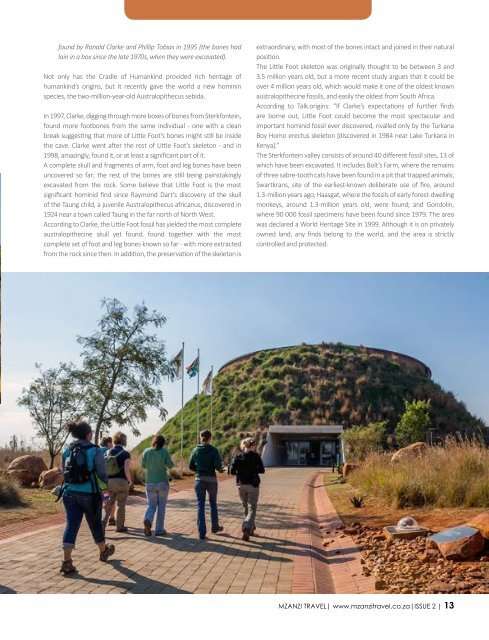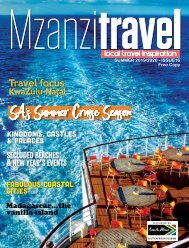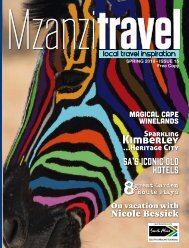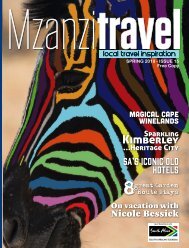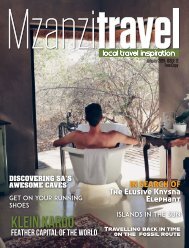MZANZI TRAVEL - ISSUE 2
MZANZI TRAVEL is a glossy, full-colour quarterly, A4 publication that sets out to showcase, foster and promote whatever South Africa has to offer to both local and international tourists.
MZANZI TRAVEL is a glossy, full-colour quarterly, A4 publication
that sets out to showcase, foster and promote whatever South
Africa has to offer to both local and international tourists.
You also want an ePaper? Increase the reach of your titles
YUMPU automatically turns print PDFs into web optimized ePapers that Google loves.
found by Ronald Clarke and Phillip Tobias in 1995 (the bones had<br />
lain in a box since the late 1970s, when they were excavated).<br />
Not only has the Cradle of Humankind provided rich heritage of<br />
humankind’s origins, but it recently gave the world a new hominin<br />
species, the two-million-year-old Australopithecus sebida.<br />
In 1997, Clarke, digging through more boxes of bones from Sterkfontein,<br />
found more footbones from the same individual - one with a clean<br />
break suggesting that more of Little Foot’s bones might still be inside<br />
the cave. Clarke went after the rest of Little Foot’s skeleton - and in<br />
1998, amazingly, found it, or at least a significant part of it.<br />
A complete skull and fragments of arm, foot and leg bones have been<br />
uncovered so far; the rest of the bones are still being painstakingly<br />
excavated from the rock. Some believe that Little Foot is the most<br />
significant hominid find since Raymond Dart’s discovery of the skull<br />
of the Taung child, a juvenile Australopithecus africanus, discovered in<br />
1924 near a town called Taung in the far north of North West.<br />
According to Clarke, the Little Foot fossil has yielded the most complete<br />
australopithecine skull yet found, found together with the most<br />
complete set of foot and leg bones known so far - with more extracted<br />
from the rock since then. In addition, the preservation of the skeleton is<br />
extraordinary, with most of the bones intact and joined in their natural<br />
position.<br />
The Little Foot skeleton was originally thought to be between 3 and<br />
3.5 million years old, but a more recent study argues that it could be<br />
over 4 million years old, which would make it one of the oldest known<br />
australopithecine fossils, and easily the oldest from South Africa.<br />
According to Talk.origins: “If Clarke’s expectations of further finds<br />
are borne out, Little Foot could become the most spectacular and<br />
important hominid fossil ever discovered, rivalled only by the Turkana<br />
Boy Homo erectus skeleton [discovered in 1984 near Lake Turkana in<br />
Kenya].”<br />
The Sterkfontein valley consists of around 40 different fossil sites, 13 of<br />
which have been excavated. It includes Bolt’s Farm, where the remains<br />
of three sabre-tooth cats have been found in a pit that trapped animals;<br />
Swartkrans, site of the earliest-known deliberate use of fire, around<br />
1.3-million years ago; Haasgat, where the fossils of early forest-dwelling<br />
monkeys, around 1.3-million years old, were found; and Gondolin,<br />
where 90 000 fossil specimens have been found since 1979. The area<br />
was declared a World Heritage Site in 1999. Although it is on privately<br />
owned land, any finds belong to the world, and the area is strictly<br />
controlled and protected.<br />
<strong>MZANZI</strong> <strong>TRAVEL</strong>| www.mzanzitravel.co.za|<strong>ISSUE</strong> 2 | 13


